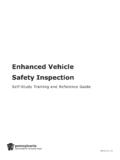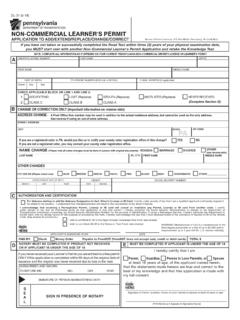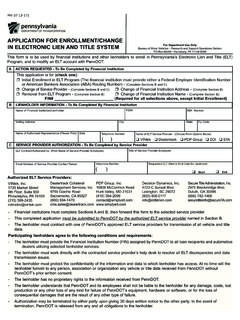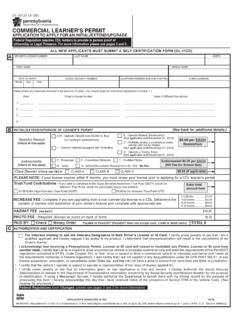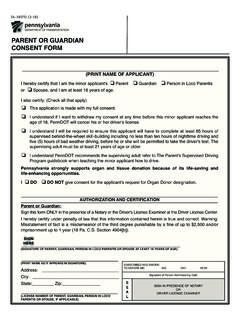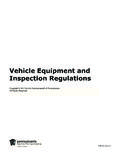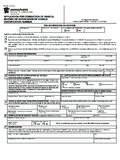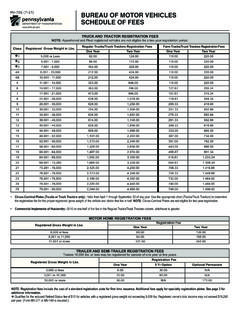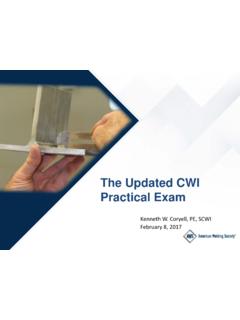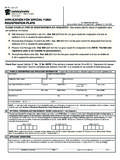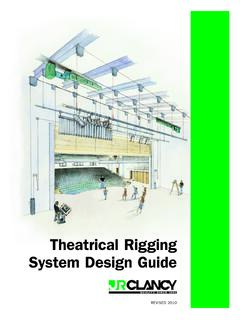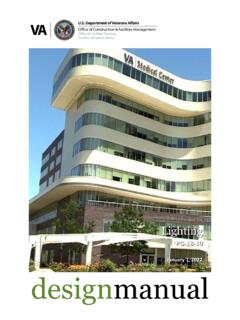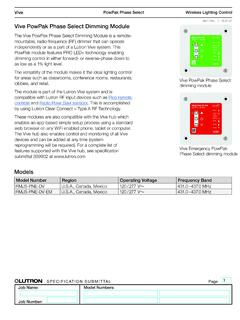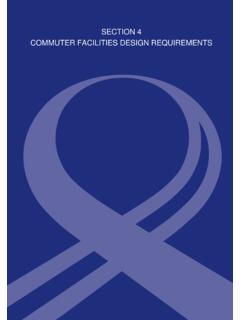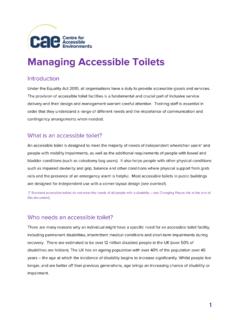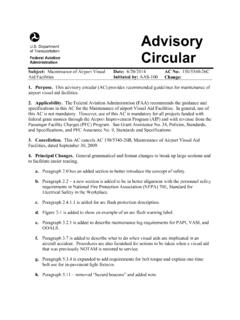Transcription of Roadside Safety Pocket Guide - dot.state.pa.us
1 PUB 652 (5-18) Roadside SafetyPocket Guide2018 EditionINTRODUCTION.. 3 PART 1 Guide RAIL BASICS.. 4 Roadside Barrier Guidelines.. 4 Clear Zone.. 5 Options (In order of preference).. 9 Types of Barrier.. 9 Length of Need (LON).. 14 Length of Need Procedure .. 15 Length of Need for Opposing Traffic.. 16 Length of Need (LON) Field Check.. 17 Additional Considerations.. 17 Deflection Distance.. 17 Height Measurement.. 18 Guide Rail Flare Rates.. 19 Barrier Placement on Slopes.. 20 Guidelines for Barriers on Slopes.. 20 Guide Rail and Curb.. 21 Guide Rail and Trees.. 22 Guide Rail Transitions.. 23 Connections to Bridge Barriers.. 24 PART 2 SPECIAL CASES.. 25 Omitted Post(s).. 25 Nested Panels.. 26 Guide Rail at Intersections and Driveways.. 27 PART 3 END TERMINALS.. 31 Crashworthy End Treatments.. 31 Crashworthy End Treatments by Type .. 32 Non-Crashworthy Terminals.. 36 Terminal Grading Details.. 37 PART 4 - MAINTENANCE.. 40 Longitudinal Barrier Damage.
2 41 Terminal Damage .. 41 Repair/Upgrade/Remove.. 42 Guide RAIL REFERENCES.. 39 Table of ContentsGuide rail systems are designed and installed for oneprimary reason: to reduce the severity of a crash bypreventing a vehicle from reaching a more hazardousfixed object or terrain feature. The purpose of thisdocument is to summarize important informationcontained in PennDOT's Publication 13M, DesignManual Part 2 (DM-2), Highway Design; Publication72M, Roadway Construction Standards; andPublication 23, Maintenance Manual into a pocketguide that can be used in the field to ensure that allbarrier installations are built and maintained to currentstandards and can be expected to perform acceptablywhen We Must Ask OurselvesWhen in the field, we need to ask ourselves thefollowing questions:1. Is the Guide rail system more hazardous thanwhat we are shielding?2. Is this existing Guide rail installation needed?3. If we terminate the Guide rail here is there apossibility of a vehicle hitting the hazard?
3 4. If we extend the Guide rail is there anotherobstruction we could be shielding?5. Are there any obstructions that are in the guiderail system's deflection zone?6. Are we terminating the Guide rail within 200 feetof the start of another Guide rail string?7. Are we terminating the Guide rail string within 200feet of a cut slope?8. Does the slope need any regrading?9. Has the Guide rail height been reset after anoverlay?10. Are we using the best end treatment for the fieldcondition?11. Are we considering Guide rail in sensitive areassuch as school playgrounds and reservoirs?12. Is there adequate backup behind strong post Guide rail or are longer posts required?3 Publication 6522018 EditionIntroductionRoadside Barrier Guidelines There are pre-determined situations or conditionswhere a Roadside barrier is normally to the tables on pages 6, 7 and 8 forembankment heights and for fixed-objectguidelines within the clear zone.
4 These guidelines should be considered in thedetermination of the need for a Roadside barrierrather than absolute criteria. They are not a substitute for engineeringjudgment. Roadside barrier guidelines are based on thepremise that a Roadside barrier should be installedonly if it reduces the severity of potential crashes. There are instances where it is not immediatelyobvious whether the Roadside barrier or theunshielded condition presents the greaterundesirable situation. In such instances, Roadside barrier guidelines maybe established by using a benefit/cost analysiswhereby factors such as design speed and trafficvolumes can be evaluated in relation to roadsidebarrier need. Costs associated with the Roadside barrier(installation costs, maintenance costs, and crashcosts) are compared to similar costs associatedwith the unshielded condition. This procedure is typically used to evaluate threeoptions: 1. Remove or reduce the condition so that it no longer requires shielding,2.
5 Install an appropriate Roadside barrier, or3. Leave the condition unshielded4 Publication 6522018 EditionPart 1 - Guide Rail BasicsThis document provides the information needed toanswer these and other questions pertaining toinstallation and maintenance considerations for guiderail systems. This publication is not to be consideredas a design Guide . District highway design personnelshould be contacted if design issues occur in the Consider eliminating short lengths of Guide railsince these sections are often more undesirablethan no barrier at all. Avoid short gaps between Guide rail installationsby making Guide rail continuous where the pointsof need are determined to be about 200 feet apartor less. Consider keeping the slope clear of fixed objectswhen Guide rail is not required due to the height of the slope. Consider Guide rail in sensitive areas such asschool playgrounds or reservoirs even when theyare outside the clear zone, which is ZoneThe term "clear zone" is defined as the total roadsideborder area, starting at the edge of through traveledway, available for safe use by errant vehicles.
6 Safeuse generally means the slope is flat enough and freeof fixed-object hazards so a motorist leaving the roadis able to stop and return to the roadway safely. Theclear zone distances shown below representminimum recommended distances and are based onlimited data. The clear zone should be made as wideas economically feasible, preferably as wide as thetabulated 6522018 Edition6 Publication 6522018 EditionMinimum Clear Zone Widths (in feet)**Since recovery is less likely on the unshielded, traversable 1V:3H slopes,consider removal of fixed objects present beyond the toe of these of the width of the recovery area provided, if any, at the toe ofslope should take into consideration right-of-way availability, environmentalconcerns, economic factors, Safety needs, and crash histories. Also, the distancebetween the edge of the through traveled lane and the beginning of the 1V:3 Hslope should influence the recovery area provided at the toe of (mph)Daily Traffic ForeslopeBackslope1V:6H orFlatter1V:5H to 1V:4H1V:3H1V:3H1V:5 HTo1V:4H1V.
7 6H or Flatter40 mphor less45 50mph55 mph60 mph65 70mphUnder 75077** 777750 1500 10 12 ** 10 10 101500 6000 12 14 ** 12 12 12 Over 6000 14 16 ** 14 14 14 Under 750 10 12 **8810750 1500 14 16 ** 10 12 141500 6000 16 20 ** 12 14 16 Over 6000 20 24 ** 14 18 20 Under 750 12 14 ** 8 10 10750 1500 16 20 ** 10 14 161500 6000 20 24 ** 14 16 20 Over 6000 22 26 ** 16 20 22 Under 750 16 20 ** 10 12 14750 1500 20 26 ** 12 16 201500 6000 26 30 ** 14 18 24 Over 6000 30 30 ** 20 24 26 Under 750 18 20 ** 10 14 14750 1500 24 28 ** 12 18 201500 6000 28 30 ** 16 22 26 Over 6000 30 30 ** 22 26 287 Publication 6522018 EditionBarrier requirements for Embankment Heights8 Publication 6522018 EditionGuide Rail requirements for FixedObjects Within the Clear Zone*Exercise sound engineering judgment and consider shielding in some specialcases where such obstructions are likely to be hit due to geometric roadwayconditions (outside of a curve, steep grade at beginning of a curve, etc.)
8 Shielding should also be considered in sensitive areas such as schoolplaygrounds and reservoirs.**A judgment decision based on relative smoothness of wall and anticipatedmaximum angle of impact (refer to AASHTO Roadside Design Guide , Table 5-2).Fixed Objects Within the Clear ZoneBarrierRequiredYesNo1. Sign Support (Ground Mounted) Post of Breakaway DesignX Non-Breakaway Design Sign SupportsX Concrete Base Extending 4 inches orzzMore Above GroundX2. lighting Poles and Supports ofBreakaway DesignX3. Bridge Piers and Abutments atUnderpassesX4. Culvert Headwalls 4 inches or moreabove groundX5. Trees*X6. Utility Poles*X7. lighting Poles with High Mast LightingX8. Retaining Walls**XOptions (In order of preference) Removethe obstruction . Redesignthe obstruction so it can be traversedsafely. Relocatethe obstruction to a point where it is lesslikely to be struck. Reduceimpact severity by using an appropriatebreakaway device or impact attenuator.
9 Shieldthe obstruction with a longitudinal trafficbarrier if it cannot be eliminated, relocated orredesigned. Delineatethe obstruction if the above alternativesare not : Guide rail can also be a hazard andshould only be used where the results of leaving theroadway and overturning or striking a fixed objectwould be more severe than the consequence ofstriking the of BarrierFlexible Systems:Weak Post W-Beam Guide RailTypes: 2-W (normal post spacing) 2-WC (close post spacing) 2-WCC (very close post spacing) Semi-Rigid Systems:Strong-Steel Post W-Beam Guide Rail with Wood or Plastic Block Types: 31-S (normal post spacing) 31-SC (close post spacing) 31-SCC (very close post spacing)Rigid Systems:Permanent Concrete BarrierWeak Post Guide Rail(2-W, 2-WC, and 2-WCC)should be used if the minimum unobstructed distancebehind the rail is available. See Deflection Table onpage Post Systemsshouldnotbe used if the fillslope is steeper than 1V:2H.
10 Weak post Guide railshall not be used around radii at intersections where it can be hit at severe impact 6522018 Edition10 Publication 6522018 EditionStrong Post Guide Rail (31-S, 31-SC, 31-SCC)should be used when the minimum unobstructeddistance behind the rail is not adequate to permit theuse of a weak post system. See Deflection Table onpage 31 Strong Post Guide RailMixing of strong post and weak post systems inthe same run of Guide rail is to be used only when theproper transition treatment between systems can beprovided, as shown on the Standard transitions between strong post and weakpost systems should be avoided. Refer to page 23for more Cable Median Barrieris installedwith a significantly greater tension in the cables thangeneric three-cable systems. The deflection of thesesystems depends on the type of system and the postspacing. The high-tension systems also result in lessdamage to the barrier and usually the cables remainat the proper height after an impact that damagesseveral posts.
